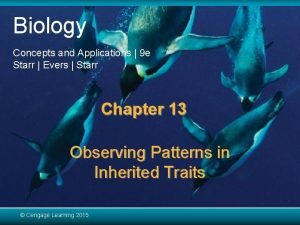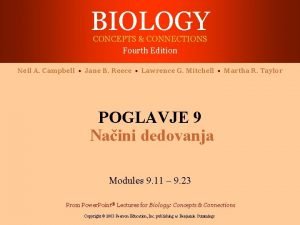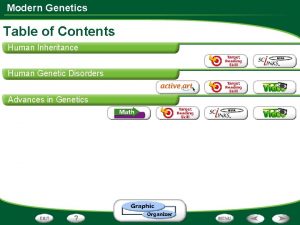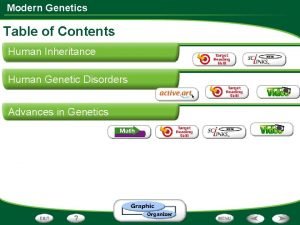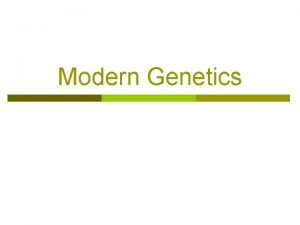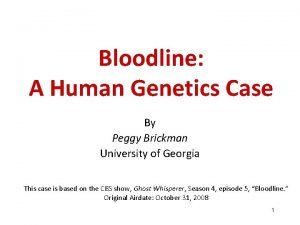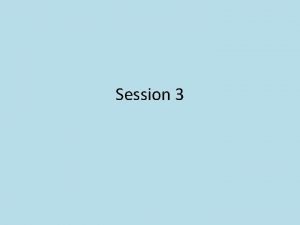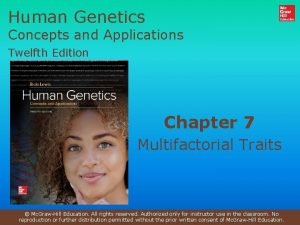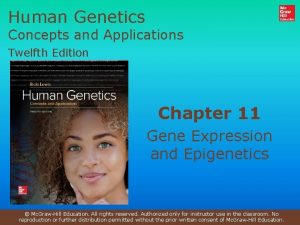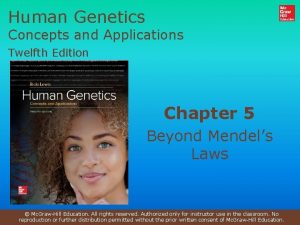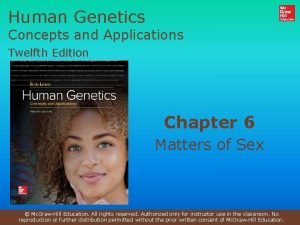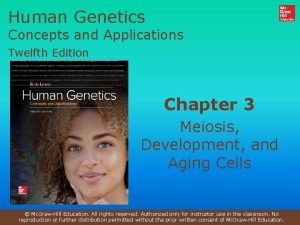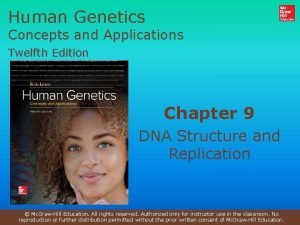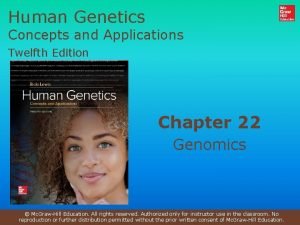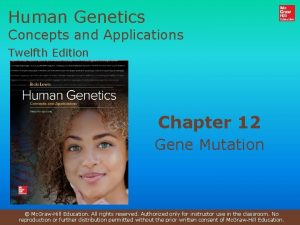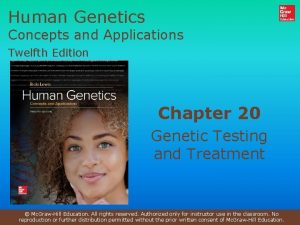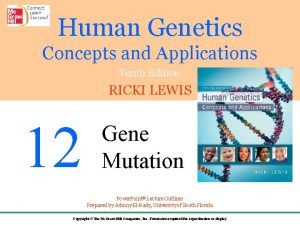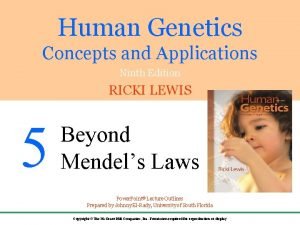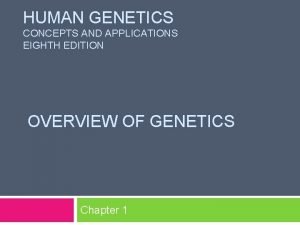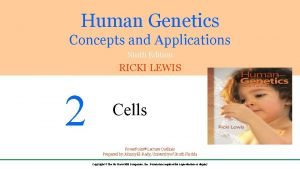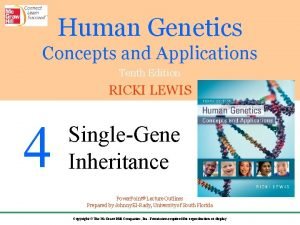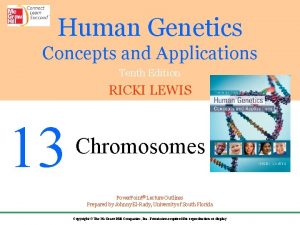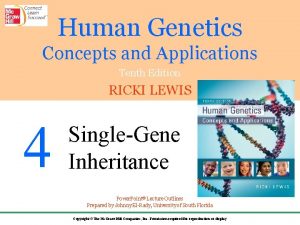Human Genetics Concepts and Applications Twelfth Edition Chapter







































- Slides: 39

Human Genetics Concepts and Applications Twelfth Edition Chapter 8 Genetics of Behavior © Mc. Graw-Hill Education. All rights reserved. Authorized only for instructor use in the classroom. No reproduction or further distribution permitted without the prior written consent of Mc. Graw-Hill Education.

Chapter 3 Learning Outcomes (1 of 3) 1. 2. 3. 4. 5. 6. 7. Identify the physical basis of behavioral traits in the brain. Explain how genes can affect behavior. Describe how studies on dogs led to discovery of a narcolepsy gene in humans. Explain how mutations in the period 2 gene disrupt sleep-wake cycles. Describe development of intelligence tests. List causes of intellectual disability. State the two identifying characteristics of drug addiction. © Mc. Graw-Hill Education. 4 -2

Chapter 3 Learning Outcomes (2 of 3) 8. Discuss genetic and neurological evidence that drug addiction is a biological phenomenon. 9. Explain how people can be addicted to drugs that are derived from plants. 10. Describe two types of receptors that are implicated in drug addiction. 11. Explain how genes control neurotransmitter abnormalities that lie behind major depressive disorder. 12. Explain how the genetics of bipolar disorder is complex. © Mc. Graw-Hill Education. 4 -3

Chapter 3 Learning Outcomes (3 of 3) 13. Explain how schizophrenia differs from the mood disorders. 14. Discuss how synaptic pruning can unite environmental and genetic contributions to elevating the risk of developing schizophrenia. 15. List factors that increase the risk of developing autism. 16. Explain three ways to use exome or genome sequence data to discover genes that contribute to autism. 17. Discuss the role of neurexins and neuroligins in causing some cases of autism. © Mc. Graw-Hill Education. 4 -4

Chapter 3 Behavior Complex continuum of emotions, moods, intelligence, and personality Occurs in response to environmental factors, but how we respond has genetic underpinnings Behavioral genetics considers nervous system function and variation • Including mood and mind © Mc. Graw-Hill Education. 4 -5

PTSD • Reaction to traumatic physical harm or perceived threat of harm • Causes anxiety flashbacks and avoidance of memories of event • Inappropriate activation of stress hormones. Combat, diseasters, crimes and disturbing events. • Developed PTSD were abused children who had the gene FKBP 5 • In abused, methyl groups on the gene were absent • With decreased methylation, stress hormones (glucocorticoids) malfunctioned • The body was unable to react and adapt to stress • Epigenetic change occurred in white blood cells as well as neural progenitor cells • When it happened early in development it lasts a lifetime and may be passed on to the next generation.

Chapter 3 Neurotransmission © Mc. Graw-Hill Education. 4 -7

Chapter 3 Behavioral Genetics Uses empirical risk, twin studies, and adoption studies Association studies with SNPs and analysis of specific mutations that are present in individuals with the behavior Genetic studies of behavioral disorders are challenging traditional psychiatric classification • Disorders may lie on a continuum with many genes having input © Mc. Graw-Hill Education. 4 -8

Chapter 3 Prevalence of Behavioral Disorders in the U. S. Population (1 of 2) Table 8. 1 12 -Month Prevalence of Some Behavioral Disorders in the U. S. Adult Population Condition Anxiety Prevalence (%) 18. 0 Social phobia 6. 8 Posttraumatic stress disorder 3. 5 Generalized anxiety disorder 3. 1 Obsessive compulsive disorder 1. 0 Panic disorder 2. 7 Autism spectrum disorders (children) 1. 5 Eating disorders 3. 0 Anorexia nervosa female 0. 9, male 0. 3 Binge eating 1. 2 Bulimia nervosa 0. 3 © Mc. Graw-Hill Education. 4 -9

Chapter 3 Prevalence of Behavioral Disorders in the U. S. Population (2 of 2) Condition Prevalence (%) Mood disorders 9. 5 Major depressive disorder 6. 7 Bipolor disorder 2. 6 Schizophrenia 1. 1 Data from the National Institute of Mental Health © Mc. Graw-Hill Education. 4 -10

Chapter 3 Sleep Vital behavior of unknown function Without sleep animals die Twin studies indicate 4 of the 5 stages of sleep have a hereditary component • Fifth stage, REM sleep, is associated with dreaming and so reflects input of experience more than genes © Mc. Graw-Hill Education. 4 -11

Chapter 3 Narcolepsy with Cataplexy Daytime sleepiness with tendency to rapidly fall asleep (narcolepsy) and periods of muscle weakness (cataplexy) Genetic basis was first identified in dogs, then humans © Stanford University Center for Narcolepsy © Mc. Graw-Hill Education. 4 -12

Chapter 3 Familial Advanced Sleep Phase Syndrome Disorder characterized by a very unusual sleepwake cycle Affected members of a large family enabled researchers to identify the first clock gene in humans • Period 2 gene on chromosome 2 enables a person to respond to day and night environmental cues © Mc. Graw-Hill Education. 4 -13

Chapter 3 Intelligence Complex and variable trait subject to multiple genetic, environmental influences, and intense subjectivity Refers to the ability to reason, learn, remember, synthesize, deduce, and create Intelligence quotient (IQ) test was first developed in France in 1904 • Predicts academic success of developmentally disabled children © Mc. Graw-Hill Education. 4 -14

Chapter 3 IQ Test Later modified at Stanford University to assess white, middle-class Americans IQ is normally distributed around a mean of 100 • • Below 50—Severe mental retardation 50– 70—Mild mental retardation 85– 115—Average intelligence Above 115—Above average intelligence Tests verbal fluency, mathematical reasoning, memory, and spatial visualization ability g value measures a general intelligence factor that represents the inherited portion of IQ Environment has less of an influence on IQ as a person ages © Mc. Graw-Hill Education. 4 -15

Chapter 3 Success and IQ IQ has been a fairly accurate predictor of success in school and work. © Mc. Graw-Hill Education. 4 -16

Chapter 3 Drug Addiction Compulsively seeking and taking a drug despite knowing its adverse effects Characteristics: • • Tolerance—Need to take more of a drug to achieve the same effect Dependence—Onset of withdrawal symptoms with cessation of drug Heritability is 0. 4– 0. 6 • Twin and adoption studies support role of genes in drug addiction. Produces long-lasting changes in the brain Brain changes that contribute to addiction are in the limbic system © Mc. Graw-Hill Education. 4 -17

Chapter 3 Events of Addiction (1 of 2) © Ryan Mc. Vay/Getty Images RF © Mc. Graw-Hill Education. 4 -18

Chapter 3 Events of Addiction (2 of 2) Drug • Alcohol • Nicotine • Cocaine Changes in expression of genes that control signal transduction; neurotransmitter synthesis; receptor abundance and activity Changes in brain circuitry (neuron connections) in limbic system Changes in behavior; dependence; tolerance © Mc. Graw-Hill Education. 4 -19

Chapter 3 Proteins Involved in Drug Addiction Enzymes involved in biosynthetic pathways of neurotransmitters Neurotransmitter-reuptake transporters Cell-surface receptors Members of signal transduction pathways in postsynaptic neuron © Mc. Graw-Hill Education. 4 -20

Chapter 3 Drugs of Abused drugs are often derived from plants • • Cocaine, opium, and tetrahydrocannabinol (THC), the main ingredient in marijuana Chemicals bind receptors in human neurons Endorphins and enkephalins are the human equivalents of opiates • Relieve pain © Mc. Graw-Hill Education. 4 -21

Chapter 3 Candidate Genes for Drug Addiction Nicotine binds a receptor that normally binds acetylcholine, causing dopamine release and pleasure Candidate genes for addiction include those that encode the: • • • Dopamine D(2) receptor Nicotine receptor parts Protein neurexin-1 • Ferries nicotinic receptors to neuron’s surface © Mc. Graw-Hill Education. 4 -22

Fig. 8. 5

Chapter 3 Mood Disorders Represent the extremes of normal behavior Types: • • Major depressive disorder—Marked by unexplained lethargy, sadness, and chronic depression Bipolar disorder—Marked by depression interspersed with mania © Mc. Graw-Hill Education. 4 -24

Chapter 3 Major Depressive Disorder Affects 6% of the U. S. population Likely cause is a deficiency of the neurotransmitter serotonin • Affects mood, emotion, appetite, and sleep Many antidepressant drugs are selective serotonin reuptake inhibitors (SSRIs) © Mc. Graw-Hill Education. 4 -25

Chapter 3 Bipolar Disorder Also called manic depression Affects 1% of the population Associated with several chromosome sites Genetic roots are difficult to isolate © Mc. Graw-Hill Education. 4 -26

Chapter 3 Schizophrenia (1 of 5) Loss of ability to organize thoughts and perceptions—withdrawal from reality Worldwide— 1% affected Typically early adult onset Progression • Difficulty in paying attention, memory and learning difficulties, psychosis (delusions and hallucinations) © Mc. Graw-Hill Education. 4 -27

Chapter 3 Schizophrenia (2 of 5) Disjointed drawings by schizophrenic patients display the characteristic fragmentation of the mind. © Robert Gilliam © Mc. Graw-Hill Education. 4 -28

Chapter 3 Schizophrenia (3 of 5) Heritability of 0. 8 and empiric risk values indicate a strong genetic component for schizophrenia. Table 8. 2 Empiric Risks for Schizophrenia Relationship Risk MZ twin 48% DZ twin 17% Child 13% Sibling 9% Parent 6% Half sibling 6% Grandchild 5% Niece/nephew 4% Aunt/uncle 2% First cousin 2% General population 1% © Mc. Graw-Hill Education. 4 -29

Chapter 3 Schizophrenia (4 of 5) Dozens of genes may interact with environmental influences to cause this disease. Environmental influences include birth complications, fetal oxygen deprivation, herpesvirus infection at birth, and traumatic brain injury or malnutrition in the mother. Infections during pregnancy is a well-studied environmental factor causing schizophrenia. It is not the infection that sets the stage for later schizophrenia, but the maternal response to it. High levels of the cytokine interleukin-8 are associated with a child developing schizophrenia. © Mc. Graw-Hill Education. 4 -30

Chapter 3 Schizophrenia (5 of 5) An important new gene finding associated with schizophrenia are the C 4 genes associated with the compliment system. Certain variants of the C 4 A genes are much more common among individuals with schizophrenia. The C 4 A variant gene causes too much pruning of synaptic connections in the brain. Microglial cells bind to C 4 A protein tags to perform the pruning. © Mc. Graw-Hill Education. 4 -31

Chapter 3 Synaptic Pruning (1 of 2) © Mc. Graw-Hill Education. 4 -32

Chapter 3 Synaptic Pruning (2 of 2) © Mc. Graw-Hill Education. 4 -33

Chapter 3 Autism (1 of 2) Spectrum of disorders: • • Characterized by loss of language, communication, and social skills beginning in early childhood Seizures and mental retardation may occur Affects 3– 6 children out of every 1000 • Strikes four times as many boys as girls Although 70 percent of people with autism have intellectual disability, others may be very intelligent © Mc. Graw-Hill Education. 4 -34

Chapter 3 Autism (2 of 2) More than 30 genes so far have been associated with autism. Two genes in particular may finally explain how autism develops. • • Encode the cell adhesion proteins neurexins and neuroligins Proteins strengthen synaptic connections in neurons associated with learning and memory In about 15 percent of people with autism, the condition is part of a syndrome. © Mc. Graw-Hill Education. 4 -35

Chapter 3 Table 8. 3 Famous People Who Had Autistic Behaviors Person Characteristics Did not like to be touched Albert Einstein Difficulty learning in school Awkward in social situations Charles Darwin Preferred letter writing to face-to-face interactions Fixated on certain objects and topics Heightened sense of smell Emily Dickinson Preferred white clothing Reclusive Fascinated with flowers Limited interests but obsessed with work Michelangelo Poor communication and social skills Relied on rigid routines © Mc. Graw-Hill Education. 4 -36

Chapter 3 Understanding Autism © Mc. Graw-Hill Education. 4 -37

Chapter 3 Syndromes That Include Autism Table 8. 4 Genetic Syndromes That Include Autism Syndrome Gene Phenotype (in addition to autism) Joubert syndrome INPP 5 E Missing brain structure (“molar tooth sign”), abnormal breathing, abnormal eye movement, cognitive impairment Phenylketonuria PAH Severe intellectual disability if remedial diet is not followed PTEN macrocephaly syndrome PTEN Large head, cancer predisposition Smith-Lemli-Opitz syndrome DHCR 7 Intellectual disability, self-injury, poor temperature regulation, disturbed sleep Timothy syndrome CACNA 1 C Webbed fingers and toes, heart defects, unusual facial features, developmental delay Tuberous sclerosis 1 TSC 1 Seizures, tumors, skin lesions © Mc. Graw-Hill Education. 4 -38

End of Presentation © Mc. Graw-Hill Education. All rights reserved. Authorized only for instructor use in the classroom. No reproduction or further distribution permitted without the prior written consent of Mc. Graw-Hill Education. 4 -39
 Human genetics concepts and applications 10th edition
Human genetics concepts and applications 10th edition Management 12th edition griffin
Management 12th edition griffin Starr evers starr biology concepts and applications
Starr evers starr biology concepts and applications Fluid mechanics fundamentals and applications
Fluid mechanics fundamentals and applications Kariogram človeka
Kariogram človeka Understanding human communication 14th edition chapter 1
Understanding human communication 14th edition chapter 1 Motivation from concepts to applications
Motivation from concepts to applications Human inheritance modern genetics answer key
Human inheritance modern genetics answer key Human clone
Human clone Modern genetics human inheritance answer key
Modern genetics human inheritance answer key 14-3 human molecular genetics answer key
14-3 human molecular genetics answer key Bloodline a human genetics case answer key
Bloodline a human genetics case answer key Discrete math susanna epp
Discrete math susanna epp Operating system
Operating system Operating system concepts 6th edition
Operating system concepts 6th edition Database system concepts seventh edition
Database system concepts seventh edition Mis chapter 6
Mis chapter 6 Zulily case study
Zulily case study One face one voice one habit and two persons
One face one voice one habit and two persons Twelfth night ppt
Twelfth night ppt Daylight and champaign discovers not more
Daylight and champaign discovers not more Twelfth night characters
Twelfth night characters Dramatic techniques in twelfth night
Dramatic techniques in twelfth night Twelfth night act 1 scene 4
Twelfth night act 1 scene 4 Carnivalesque in twelfth night
Carnivalesque in twelfth night Themes in twelfth night
Themes in twelfth night Twelfth song of thunder figurative language
Twelfth song of thunder figurative language Twelfth night act 5
Twelfth night act 5 Duke orsino character analysis
Duke orsino character analysis Jenny phelps
Jenny phelps The twelfth of never
The twelfth of never Satire in twelfth night
Satire in twelfth night Deverell twelfth night
Deverell twelfth night I disappeared on the night before my twelfth birthday
I disappeared on the night before my twelfth birthday Shakespearean comedy vs tragedy
Shakespearean comedy vs tragedy Human needs and human development
Human needs and human development Chapter 8 human needs and human development
Chapter 8 human needs and human development Pedigree miscarriage symbol
Pedigree miscarriage symbol Chapter 22 genetics and genetically linked diseases
Chapter 22 genetics and genetically linked diseases Chapter 10 sexual reproduction and genetics
Chapter 10 sexual reproduction and genetics


